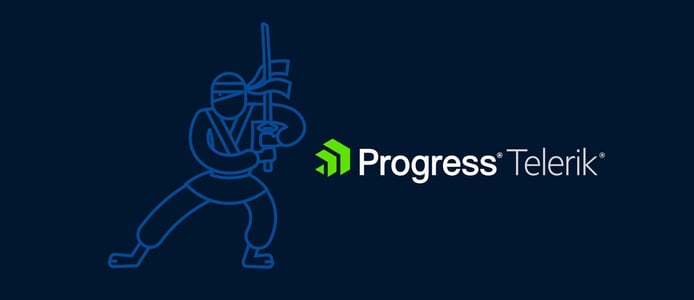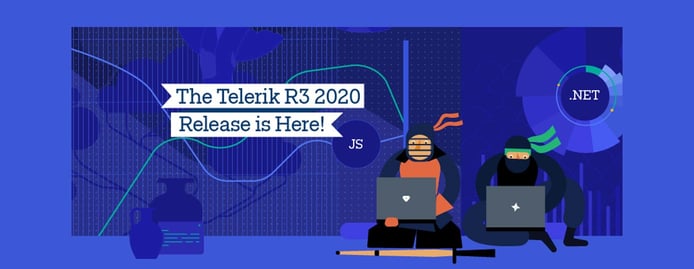
TL; DR: Users today demand outstanding web, mobile, and desktop experiences — and Progress is helping developers oblige with professional, feature-rich UI components from Telerik and Kendo UI. The tools help developers deliver more in less time while adopting the latest tech and user experience trends in their app and site-building projects. Ultimately, Progress aims to serve as a partner to developers, ushering them along their project journeys with high-level support.
Business leaders commonly elevate their developers to superhero status, expecting them to continually achieve more in less time. But even the most powerful warriors need a little outside help to conquer difficult projects. After all, where would Wonder Woman be without her lasso, or Aquaman without his trident?
Likewise, for today’s developers, the prospect of squeezing more productivity out of jam-packed days seems impossible without the proper resources. That’s why some companies are working to equip developers with the weapons they need to boost productivity and reduce dev time, all while keeping up with the latest technologies and user expectations.

DevCraft combines all Telerik .NET tools and Kendo UI JavaScript components in one package.
Take the UI components Progress delivers via feature-rich products like Telerik and Kendo UI, for example. The tools outfit developers with everything they need to build modern applications in an ever-changing technological landscape.
“The world has shifted in terms of the way users engage with technology; applications that were previously designed for fun or convenience have now become necessities,” said Sara Faatz, Director of Developer Relations at Progress. “Our goal is to provide quality UI, testing, design, and productivity tools so developers can focus on the functionality of the app, delivering better experiences across the board.”
With the support of the company’s technical staff — provided by the same developers who build Telerik and KendoUI — users also have a strong partner to turn to during their app and site-building journeys. The result is better operational agility, increased app performance, and streamlined workflows across a wide range of development frameworks.
Progress: Providing UI Components via Telerik and Kendo U
Telerik was formed as a company and product line in 2002 by four alumni from the American University in Bulgaria and the Technical University of Sofia.
“Telerik started as an ASP.NET Web Forms component suite before expanding its application development tools,” Sara said.
Progress, a global software company aiming to streamline the development, deployment, and management of business applications, acquired Telerik in 2014. The deal helped Progress provide comprehensive services across the development lifecycle.
“Today, Telerik represents our .NET line (including Blazor and ASP.NET Core, MVC, Web Forms, WPF, WinForms, Xamarin, and more), while Kendo UI represents our JavaScript lines of tools (Angular, React, jQuery, and Vue),” Sara told us. “They all sit under the same dev tools house of cards if you will.”

With its latest release, R3 2020, Progress introduced more than 45 new components across the Telerik and Kendo UI product lines.
The company’s DevCraft product now combines all Telerik .NET tools and Kendo UI JavaScript components in one package. In its capacity at Progress, the Telerik team has delivered even more value to the merged company’s customer base. In late January, for example, Telerik and Kendo UI unveiled 50-plus new components for Telerik and Kendo UI as part of its latest release — R1 2021.
“One of the benefits of being part of Progress is that it allows us to innovate and explore,” Sara said. “We had the luxury of being first to market with Blazor, and we continue to look at things like .NET Multi-platform App User Interface (MAUI), which will be the evolution of the Xamarin toolkit.”
Sara told us Blazor has been a game-changer in the dev world, empowering .NET developers to build interactive web UIs using C#, rather than learning JavaScript. On the JavaScript side, React’s open-source library for building user interfaces has soared in popularity.
“For us, it’s about staying up to date on framework proliferation and making sure that our developers understand that they’re supported, whether they’re working on legacy applications or they want to take the most modern, cutting-edge approach,” Sara said.
Boosting UX, Performance, and Operational Agility
Progress delivers developers ample flexibility in terms of modernization in general.
“The need to modernize is something that developers faced all the time,” Sara said. “With a toolset like ours, they could modernize the frontend before they modernize the entire application. Or, if they want to build a greenfield application from scratch, they can start with the most modern framework they want, or pick the right framework for the job.”
The company’s development suite is so robust that developers can rest assured that all framework options are readily available.
Besides supporting the latest .NET and JavaScript front-end frameworks and exploring new ones, the Progress team is working on bridging the gap between designers and developers.
“Design systems are something we hear a lot about in the enterprise,” Sara said. “We think that we can democratize them and make development that much easier, whether you’re a consultant or you’re working as part of a large team.”
Telerik was initially designed to help developers who do not have the assistance of in-house designers create beautiful applications on their own. The tools have since evolved to include customizable themes and other tools to support design creation. Sara said that as end-users become more demanding in terms of user experience, developers will need to become increasingly empathetic to their needs.
“I think that’s the next trend in application development,” she said. “In many cases, a designer will sketch an app and say, ‘This is what we want it to look like,’ and the developer turns around and says, ‘This is what I can do.’”
The user experience can take a nosedive when these two visions do not align — for instance, the buttons on an app or website-building project might not look the same, or the grid might not look the same. Sara said such concerns might seem trivial, but they’re not when you’re designing for the user experience.
“As we dig deeper, we understand that there’s more that we can be doing to help bridge that gap and help support the creation of design systems, help educate developers on what these systems are, and help them create their own using either our tools or others,” she said.
Backing Solid Components with Helpful Human Support
Progress boasts a good list of products — from the DevCraft platform, featuring web and mobile-focused tools like Kendo UI and Xamarin, to reporting, testing, and debugging solutions. But the thread holding all of these services together for developers working on web apps and website building is knowledgeable and attentive customer support.
“Software like ours is about more than the component or technology itself,” Sara said. “It’s about the people behind the tools. I might be biased, but we have an incredibly talented group of engineers and designers. And we have excellent people ready to help. Our support team has won awards for their service. They are real people working 24/7 to support the products and customers. That is key.”
Sara said that serving as a division of Progress allows for broadened viewpoints and product offerings. In March 2019, for example, Progress acquired IPSwitch, a provider of secure data file transfer and network management software. In September 2020, the company announced the acquisition of Chef, an infrastructure automation tool for DevOps and DevSecOps.
“Progress is a large company, and we sit in one division of that, but we do a lot of cross-functional work that allows us to gain different perspectives,” she said. “You see that in the tools and products themselves. We’ve learned a lot from IPSwitch and look forward to collaborating with our new colleagues at Chef on best practices. That’s definitely an area that helps differentiate us.”
Advancing User Experiences in Blazor, Angular, and React
Moving forward, the Progress team plans to continue its focus on Blazor, Angular, and React while still providing support and updates to the other frameworks.
“There’s a lot of passion behind that effort,” Sara said. “We’re also excited to see what happens with .NET MAUI as the evolution of Xamarin, and we’re actively evolving our testing products, which is very important when you have new frameworks like Blazor.”
The team is also exploring advances in augmented and virtual reality.
“We’re using it for potential safety applications, helping large organizations and manufacturing companies build out training,” Sara said. “While we continue to push forward with new frameworks, we don’t want to sit by idly and build components. We want to provide developers with better testing, training, and design tools in the long run.”
HostingAdvice.com is a free online resource that offers valuable content and comparison services to users. To keep this resource 100% free, we receive compensation from many of the offers listed on the site. Along with key review factors, this compensation may impact how and where products appear across the site (including, for example, the order in which they appear). HostingAdvice.com does not include the entire universe of available offers. Editorial opinions expressed on the site are strictly our own and are not provided, endorsed, or approved by advertisers.
Our site is committed to publishing independent, accurate content guided by strict editorial guidelines. Before articles and reviews are published on our site, they undergo a thorough review process performed by a team of independent editors and subject-matter experts to ensure the content’s accuracy, timeliness, and impartiality. Our editorial team is separate and independent of our site’s advertisers, and the opinions they express on our site are their own. To read more about our team members and their editorial backgrounds, please visit our site’s About page.

